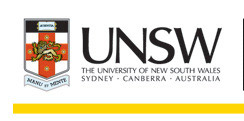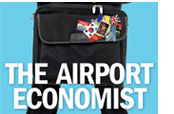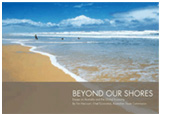Kiwis can fly: What’s next for the CER between Australian and New Zealand?
By Tim Harcourt*
I travel to many economies for a living. About 58 in 5 years at last count. But if you or I wanted to travel the ultimate underperforming economy, one with double digit inflation and unemployment, an Olympic gold medal standard for strikes, a fixed exchange rate, few foreign tourists or foreign students and protection all round, then we’d have to be a time traveller and go back to Australia in 1983. You’d find all those aspects, in Australia 30 years ago, despite the mineral wealth we still had, plus you’d be flat out getting a decent Chinese, Thai or Vietnamese meal anywhere.
In fact the only place worse economically than Australia then (given natural endowments) was New Zealand. At the time, the Kiwis were regarded as the most regulated economy in the developed world (apart from communist East Germany) and they had an inflation rates and mortgage interest rates both at 16 per cent and the top marginal tax rate at 66 per cent to show for it. New Zealand trade was also heavily regulated, tariff ridden and subsidised, and exporting was considered a mugs game as it pretty much took a cabinet submission to get a ship load of frozen peas through the docks. The UK joining the European Union had stuffed New Zealand’s lucrative export markets and they were turning inward as a result.
But that all changed on both sides of the Tasman in 1983 when we signed the Closer Economic Relations (CER) deal which was the successor to the New Zealand Australia Free Trade Agreement (the original NAFTA) which was considered to be more a ‘non aggression pact’ than a true free trade agreement (and believe me we needed a non-aggression pact with New Zealand after Trevor Chappell infamously bowled an underarm in a controversial cricket clash between the trans-Tasman rivals in 1981).
The CER was the first deal of its kind and it unleashed a new export culture on Kiwis and Aussies who had been used to protection as if it was a national pastime. The CER enabled Kiwis and Australians a foothold in the outside world and allowed local businesses to venture beyond their own borders.
The CER has been an essential part of the transformation of the New Zealand and Australian economies (as the American economic commentators say, “we went from down under to down wonder,”) and I must say as an ‘airport economist’ from an Australian point of view and I see Australia’s global transformation everywhere I go from China to Chile, Korea to Kazakhstan, and Mumbai to Mongolia.
But I must admit wherever I see Australian export presence beyond our shores, I also see New Zealand too. If there’s Beerenberg jam from Hahndorf in the hotel or on the plane, I bet there’s New Zealand Anchor butter there too. If there’s a good South Aussie Shiraz or Cab Sauvignon, at hotel restaurant, I bet there’s a Kiwi sauvignon blanc from Marlborough or a pinot noir from central Otago there too. If there’s an Australian manufacturer checking out how to join a global supply chain, I bet Fischer and Paykel have already been there too. In fact, when I worked for Austrade as chief economist and visited China, South Korea, Chile etc I was always offered a briefing from the NZ Trade Commissioner (experts like Pat English, now head of the NZ-China Business Council) as well as my own colleagues in the Australian embassy too.
So why has Australia prospered? And why has NZ? Is it just rocks and crops (minerals and agriculture)? In the Australian case, yes, that’s part of the story. And you can probably explain the Australian-NZ economic divergence in terms of Australian mineral wealth that NZ lacks. But lots of nations have minerals but are not economically successful. This is because Institutions also matter.
This is the essential message of Why Nations Fail (by Harvard/MIT) and Why Australian Prospers by Ian McLean, a distinguished economic historian from the University of Adelaide, my honours supervisor and originally, a Kiwi (of course!).You can see how economic institutions matter if you compare the economic history of Australia and Argentina (see my article ‘Don’t buy from me Argentina’), where two nations with very similar resource endowments, reliant on immigration, started in a similar place in the 19th century (in fact Argentina was richer than Australia) only to see the latter’s position squandered by poor institutions, a lack of trust and poor public policy choices.
And trade matters too. Like Australia and Argentina, if you compare the economic history of NZ and Uruguay, the South American country too was richer than NZ in the 19th century, but as the New Zealand Institute of Economic Research (NZIER)’s Chris Nixon says, we locked them out of world trade via the Ottawa Agreement of 1932 that reinforced Commonwealth preferences in trade. And in today’s very different global trading regime it is better to be an insider like Australia and NZ not an outsider locked out like Uruguay squeezed between Mercosur giants Brazil and Argentina. Just imagine if Uruguay had the trade position of say Chile, another smaller South American economy but one that is open and looking west to the Asia Pacific?
But when we look at the multiplicity of trade agreements in today’s global economy the CER is certainly the star of the show and CER played a big role too in the prosperity of both Australia and NZ. It is considered to be “world’s best practice” when it comes to trade agreements, and given the state of the NZ and Australian economy in 1983, it needed to be.
CER has brought benefits to Australia and NZ on both the macroeconomic and microeconomic level.
There are bilateral benefits, at the macro level, as it allowed trans-Tasman trade to recover, which had actually been higher in the 19th century than in the 20th. Federation didn’t help, Trans Tasman trade went backwards then, but domestic policy hurt both countries. On the investment front too, it allowed Trans Tasman investment to increase almost 60 fold.
At the micro level, perhaps more importantly, CER gave Australian small and medium enterprises (SMEs) a kick start in heading over the ditch. There are now over 16,400 Australian exporters selling goods to New Zealand (around 34 per cent of SMEs sell to NZ) and many small companies got their big break in the export game, selling “across the ditch”. Ducats, a Shepparton based ice cream company, who had been a domestic business for 83 years before CER selling ice cream to Dunedin (not quite the south pole but close!) to the south pole, is a good example as is Brisbane based Digsiport (set up, dare I say it, by a former Wallaby) who also used NZ as a nursery market for global expansion. And there are others in professional services such as Attache a software accounting firm, not to mention ties ups in banking (Commonwealth Bank and ASB) and law (Minter Ellisons and Rudd Watts and Stone).
In turn CER enabled Kiwi SMEs to go global as the majority accessed CER of all the other trade pacts, and it helped with market access as well as giving NZ businesses scale. As NZ Trade and Enterprise says: “CER created for NZ businesses a single regional domestic market five times the size of New Zealand itself.” Not only did CER, became a ‘model agreement’ for the rest of the world but it gave Australia and NZ a great platform for opening up to Asia, Latin America and the rest of the world (especially in emerging markets) and when you think of what market access Australian exporters had in 1983, 2003 and now in 2013, It’s not a spaghetti bowl of trade agreements but a comprehensive set of regional and global agreements that the CER enabled us to be a part of.
So what’s next for CER?
It some ways we’ve grabbed the “low hanging fruit” in terms of tariff barriers and subsidies, it now gets a bit harder now as we try and harmonise intellectual property (IP), industry standards, competition policy and even consider combining our productivity commissions (surely they’d believe in improved efficiency!)
There has often been talk of a common currency (former Australian Deputy Prime Minister and Trade Minister Tim Fischer wanted to call it the ‘Zac’ short for ANZAC) but we need to be careful not to go too far – that’s NZ political scientist Shaun Goldfinch’s warning who has studied economic reform in both countries – and you only need to glance at Europe and the problems a common currency has caused.
But there are things we can still do with CER for our mutual benefit. Yes we can use CER as a model for other economies looking to open their economies. We can use CER as a springboard into Asia and Latin America and other emerging markets. The benefits of an “Anzac” business mission to a third markets (such as an ANZAC biotech mission to Chile) would be potentially more beneficial than a marginal increment in the bilateral relationship. And we’ve already seen many examples of these ANZAC Partnerships such as the PGG Wrightson Genomics & Australian Molecular Plant Breeding CRC, the New Zealand Bio Pacific Futures & Australia’s Horizon Science, the NZ Government Solid energy – Australia’s geosequestrian CRC, and the aforesaid Australian – NZ Biotech Partnership Fund.
Using the CER to create third market trade and investment opportunities is important to both nations, as when the terms of trade comes off, if high exchange rates continue, we will need to boost productivity, and our trading ties in Asia and Latin America can play a big role in this quest. Sure some institutional integration is useful but respecting national sovereignty under what the NZIER calls the ‘collaboration-co operation’ model. This has occurred with the Productivity Commissions, in competition policy and in areas where Austrade and New Zealand Trade and Enterprise could potentially pool services in third markets. And we also co-locate our Geneva Missions to the WTO, NZ has membership of Australia’s state ministerial council on international trade and there’s potential for cross board appointments and in our Industry Capability Network
In conclusion, CER is world’s best practice – it has to be – and it has survived many twists and turns in the Trans Tasman relationship over the past 30 years. Because the NZ-Australia relationship is strong but we have had some tensions (in the air in aviation and along the ground thanks to the Chappells), cases of mistaken identity (Russell Crowe, Sam Neill, Phar Lap, Pavlova and many more), and an up and down history in the relations of our political leaders both in the past and today. We have also been left us with different perceptions of the relationship that we have struggled with from Australian federation to today. The CER has always given is a frame work to deal with these ups and downs. But given that leadership matters, I must conclude that as an Australian I admire the leadership of one of New Zealand’s greatest leaders, Sir Edmund Hillary, (to whom I am distantly related) who climbed Mount Everest but also I understand from relatives he was a hell of a bee keeper as well. And I think in terms of economic reform, CER allowed us to climb many mountains and together as NZ & Australia, trade partners but sovereign nations, and like Ed Hillary, we’ll be able to tackle many more economic peaks beyond the horizon in years to come.
* Tim Harcourt is the J.W.Nevile Fellow in Economics at the Australian School of Business, UNSW in Sydney and author of The Airport Economist:
http://blogs.unsw.edu.au/theairporteconomist/
www.theairporteconomist.com
This article is based on an address to the Australian and New Zealand Leadership Forum in Sydney, 27th November, 2013. Thanks to Chris Nixon of NZIER for his comments and assistance.













No Comments so far ↓
Comments are closed.